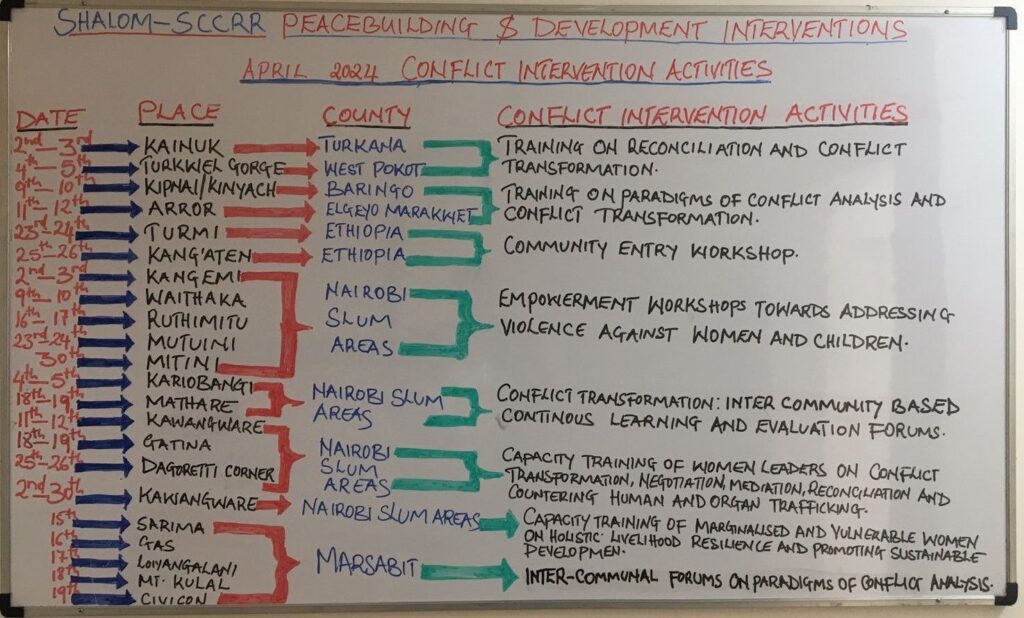
Patrick Sullivan in Kenya.
Editor’s note: Patrick Sullivan is a 30-year veteran with the New York city Police Department, serving as an attorney in the NYPD’s Department of Law. This story is a special guest essay on his visit to Kenya last summer and his time with the team from the Shalom Center for Conflict Resolution and Reconciliation. All photos by Patrick Sullivan.
By Patrick Sullivan
This past summer I had the opportunity to fulfill a long held dream and visit Africa.

The Shalom team leading a workshop. [Photo by Patrick Sullivan]
Our Kenyan trip was spent almost entirely at the Yarumal missions of Lodundokwe, Barsaloi and Tuum in Samburu County located in Northern Kenya who are engaged in much needed development work. Conditions are harsh. The land is considered semi desert and even the winter is extremely hot. Resources are scarce and hardships engendered by the ever present shortage of water during the dry season are compounded by a lengthy drought.
The Samburu are a pastoral people. They keep small herds of goats, cattle and camels. When a water supply disappears they must move their community group to another source. The region is home to other pastoral groups who vie for the same scarce resources. From what I understand escalating violence became a major problem when a proliferation of rifles occurred in the 1990s. Since then clashes resulting in loss of life and population dispersal have repeatedly flared.
![Parkatta landscape. [Photo by Patrick Sullivan]](https://shalomconflictcenter.com/wp-content/uploads/2016/04/Cross-on-hill-Parkatti-300x225.jpg)
Parkatta landscape. [Photo by Patrick Sullivan]
As you enter the mission compound you are greeted by a sign reading “Tuum Parish Land of Peace” with a red line painted through an automatic rifle. During our stay the mission hosted a week of sports activities for the youth of both tribes in an effort to bring them together.
Shalom team members had arrived at Tuum en route to the Turkana village of Parkatti. Our group led by Yarumal missionaries Father German and Deacon Nhial Jacob travelled with Shalom in two vehicles. Parkatti is only 25 kilometres from Tuum village but the journey was an ordeal. Most of the unpaved road really doesn’t exist and the terrain is extremely rocky and hilly. Parkatti is small, poor, isolated and very hot. The people have dug wells but the water is contaminated and not fit to drink. We were exhausted as we arrived but the welcome we received was amazing. The village greeted us with incredible warmth. They were especially grateful for the return of the Shalom team.
![A Shalom village meeting. [Photo by Patrick Sullivan]](https://shalomconflictcenter.com/wp-content/uploads/2016/04/Shalom-Meeting-300x225.jpg)
A Shalom village meeting. [Photo by Patrick Sullivan]
For the next two days I had the privilege to see the Shalom team at work. Their program was well planned and superbly executed. It was structured into a sequence of meetings that served as a step by step process to identify the causes of the friction, seek commonalities and open lines of communication between the communities.
The first afternoon and evening the villagers gathered in a shady area while Godfrey Okoth and Elizabeth Atieno conducted the meeting. This session was designed to elicit the reasons for the conflict. They didn’t just assume it was an ethnic matter between the Samburu of Tuum and the Turkana of Parkatti. Some people were reluctant to speak but Godfrey and Elizabeth succeeded in gaining their confidence and getting people to contribute to the discussion. Competition for scarce resources and water were discussed. People stated that previously they had few problems when visiting Tuum. In fact Tuum residents had warned them of danger and said that outsiders were instigating trouble. The meeting was so well conducted it was like watching a real life application of a university lesson on conflict resolution.
At night the village youth gathered for an informative peace movie shown by the team. The movie screen was a sheet of canvas draped across the rear of their truck.
![Entrance to Tuum mission. [Photo by Patrick Sullivan]](https://shalomconflictcenter.com/wp-content/uploads/2016/04/Entrance-to-Tuum-Mission-225x300.jpg)
Entrance to Tuum mission. [Photo by Patrick Sullivan]
I was so impressed with the Shalom’s professionalism and methodology that I peppered a very patient Godfrey with questions. This expedition to Parkatti was hardly exceptionable. The team travels constantly throughout the country attempting to mediate between groups and bring conciliation. There is very little stationary time in Nairobi.
Now that I’m back in New York, I think of my time in Kenya often – and I remember the engagement and expertise of the Shalom team very well. Their work is so important, and their professionalism and deep knowledge is something that I appreciate, given my own training. The work for peace is not easy. My own office is only a block from the World Trade Center site, and every New Yorker remembers when violence visited our city. My work as a police officer is aimed at keeping the peace here in New York. Having seen Shalom in action, I am very glad that Fr. Patrick and his team are working so hard in Africa.

